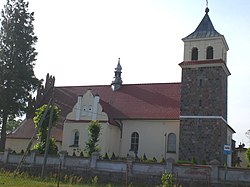Czarnylas [t͡ʂarˈnɨlas] is a village in the administrative district of Gmina Skórcz, within Starogard County, Pomeranian Voivodeship, in northern Poland.[1] It lies approximately 6 kilometres (4 mi) north-west of Skórcz, 15 km (9 mi) south of Starogard Gdański, and 60 km (37 mi) south of the regional capital Gdańsk. It is located within the ethnocultural region of Kociewie in the historic region of Pomerania.
Czarnylas | |
|---|---|
Village | |
 Saint Andrew church in Czarnylas | |
| Coordinates: 53°50′26″N 18°29′31″E / 53.84056°N 18.49194°E | |
| Country | |
| Voivodeship | Pomeranian |
| County | Starogard |
| Gmina | Skórcz |
| Population | 473 |
| Time zone | UTC+1 (CET) |
| • Summer (DST) | UTC+2 (CEST) |
For details of the history of the region, see History of Pomerania.
The landmark of Czarnylas is the Saint Andrew church, which dates back to the 14th century.
History
editCzarnylas was a royal village of the Polish Crown, administratively located in the Tczew County in the Pomeranian Voivodeship.[2] It was annexed by Prussia in the First Partition of Poland in 1772, and restored to Poland, after Poland regained independence in 1918.
During the German occupation of Poland (World War II), teachers from Czarnylas were among Polish teachers murdered by the Germans on October 20, 1939, in the Szpęgawski Forest as part of the Intelligenzaktion.[3] Polish inhabitants of Czarnylas were also murdered in large massacres carried out in late 1939 in the Szpęgawski and Zajączek forests.[4]
References
edit- ^ "Central Statistical Office (GUS) – TERYT (National Register of Territorial Land Apportionment Journal)" (in Polish). 2008-06-01.
- ^ Marian Biskup, Andrzej Tomczak, Mapy województwa pomorskiego w drugiej połowie XVI w., Toruń, 1955, pp. 110-111 (in Polish)
- ^ Maria Wardzyńska, Był rok 1939. Operacja niemieckiej policji bezpieczeństwa w Polsce. Intelligenzaktion, IPN, Warsaw, 2009, pp. 148-149 (in Polish)
- ^ Wardzyńska, pp. 150, 153
